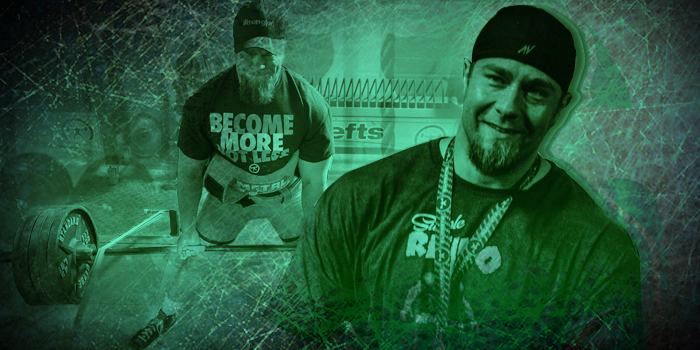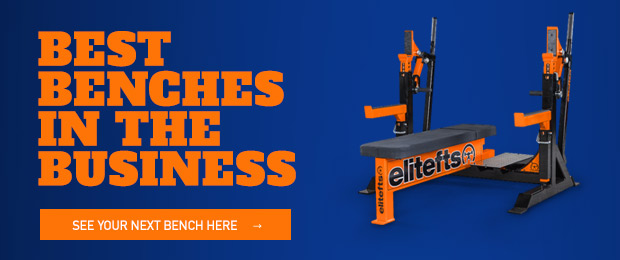
As an aging lifter with 30 years of training under my belt, I have my share of aches and pains. I have been forced to train as a bench-only lifter after knee surgery and am now battling a heel spur that makes walking difficult at times.
If you are a bench-only lifter by choice or circumstance, you should be training your lower body in some capacity. Both compound and isolation movements should be used to help with total body strength and improving the bench press.
RECENT: A Better Language for Coaches
After a few months of dropping squats and deadlifts, there was a noticeable difference in my lats and upper back strength. Doing more shrugs, face pulls, and lats work helped but did not make up for the volume and intensity of max effort or dynamic effort squats, deadlifts, and heavy good mornings. The size and strength from those three made a world of difference in my bench. But if you can’t do those, what should you do?
I have put together a list of exercises for those of us who are beat-up and might not be able to use a straight bar or even perform a normal squat or deadlift. Bad knees, backs, and hips may keep you from a three-lift total, but you can’t let it keep you down. These exercises are my workaround to hammer your lower and upper body to keep your bench strong.
Yoke Bar Box Squats
Yoke Bar Box Squats are the low-hanging fruit on my list. Extra stress on the upper back without beating up the shoulders is the key here. The yoke bar raises the bar up two plus inches, lengthening the spine while forcing the back to work harder. No matter how you perform them, you will be limited to less weight than you can use with a straight bar because of the camber. Making the main exercise harder with less weight helps with less wear and tear, keeping you healthy to bench.
If you do have ankle, back, knee, or hip issues, you obviously want to consult a doctor before starting any lower body exercise. If something hurts, don’t do it. Other modifications, like adding bands, chains, forward anchored bands, or reverse bands, might be the answer you need to work around those pains.
Wide-Grip Romanian Deadlifts
Keeping your stomach up and not flattening out on the bench is critical. Ever done a decline bench? It shortens the bench stroke and allows you to use more of the lats. Not only will Wide-Grip Romanian Deadlifts teach you to arch hard and hit your upper back, but your lats will work extremely hard at keeping the bar in close to you.
Use your competition bench grip, and you will see how much harder your whole upper back must work to keep that bar in close. Getting your body to work as a unit will keep your body more solid on the bench. The added bonus here is the glute work. Get those glutes bigger and stronger so you can keep it locked onto the bench. I love sets of six to twelve reps for this exercise.
Yoke Bar Upper Back Good Mornings and Hise Shrug Combo for Time
This exercise can be dropped into the assistance exercises in the upper or lower body or be used for an extra workout. Rounding and losing some tension in the lats and re-arching will build mass and those hard-to-reach areas of the upper back that shrugs and pulldowns won’t hit.
This exercise should be done for one set of two to five minutes. I would err on the light side and work up to one plate. Try for 20 Upper Back Good Mornings and then Hise Shrugs. As you get tired, the number of reps will change, but keep going and reach for maximal time under tension.
Reverse Hypers
This should be a no-brainer, not just for strength but overall back health. Doing 100 to 125 reps twice a week will not only keep your back healthy but also net you just as many extra ab and lats contractions. This extra ab work will help keep the back safe and give you something to push up when bringing the bar down on the bench. I understand that this is not one of those movements that is very fun and glamorous, but it should be a staple in your training. There are many ways to skin this cat. It doesn’t matter what way you choose; you just need to do them. If you need ideas, read my article, 11 Set and Rep Schemes for Massive Reverse Hyper Back Pumps.
Good Morning Squats
Want to hit everything from top to bottom? Then this is for you. Because each rep takes longer than just a single squat or good morning, you are forced to lighten the weight. Each rep will require you to focus on re-tightening the lats and arching hard when you get into the bottom. If you need to make it even harder, do them on a box. The time it takes to sit and come back up from a dead stop makes the light weight extremely hard on the legs.
Four or five sets of six to twelve reps of this supplemental exercise will add mass and strength right where you need it. If you are feeling brave, hit this exercise for heavy singles or triples. No matter if you need quads, hamstrings, lats, or upper or lower back work, you can choose a specialty bar to hit that spot.
*If using a box, make sure to come straight up and not roll forward off the box.
Back Raise Deadlift — 45 degree or on Glute Ham Raise
Much like the Wide-Grip Romanian Deadlifts, Back Raise Deadlifts will put a large amount of work on the lats. Each rep you must pull back like a heavy partial pullover. If you have trouble with the bench bar drifting back over your face, this is a great way to help fight that. It will also help if you have a habit of the bar drifting away from you when you deadlift. Arch hard, drive those hands toward your hips and squeeze those glutes hard.
Having a strong lower body is not necessary for a big bench, but it sure won’t hurt. Using big exercises to reinforce your normal lats and upper back training will solidify your base. No matter how many pulldowns and rows you do, it is hard to make up for what heavy squats and deadlifts will do for you.










